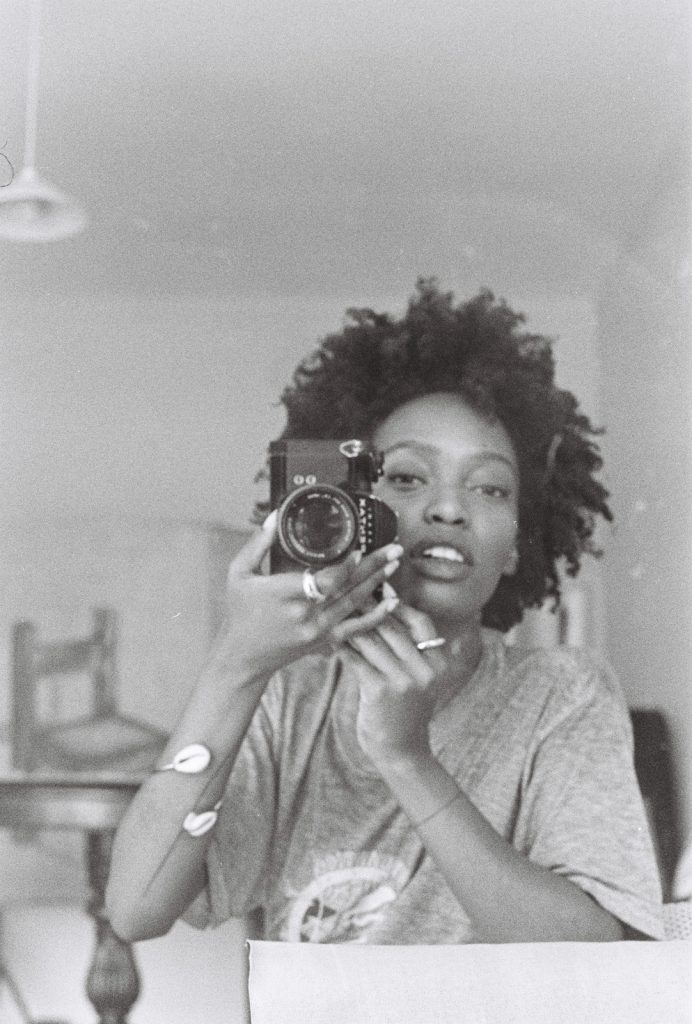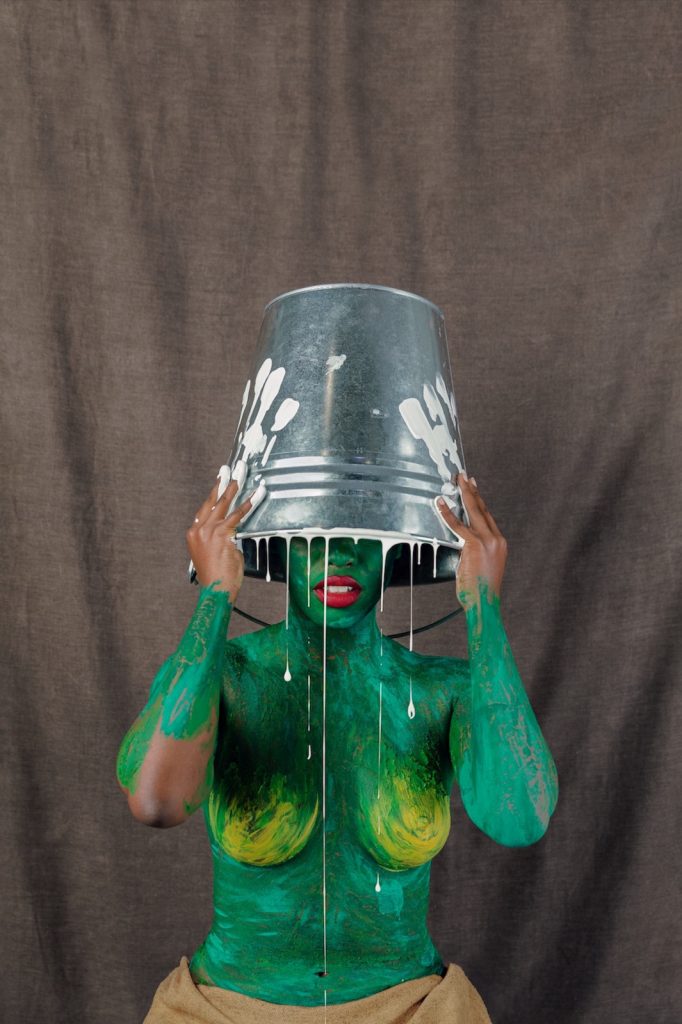Land of Milk and Honey
Tony Gum recently celebrated her 27th birthday. I am taken back to 2016, when she was on the cover of Destiny magazine’s Youth Month issue, aged 20. Back then, a visual artist, especially one as young as she, was something that had never been done by the brand. For her, this was a career defining moment.
 Tony Gum
Tony Gum
As someone who had witnessed her growth from blogger to photographer to visual artist, I wondered if she realised how her trajectory would contribute to art being taken seriously as business.
“2016 was the icing on the cake for the years prior to what would inform the artist that I am today,” she says. “During my gap year as well as my years of studying, I always had a side job or a ‘tangent’ that would fulfil my creative outlets. Never in my mind would I have thought that it would become a viable career — I was creating because it fulfilled me. It was at that point where my brother interjected to educate me on the business of art as well as to manage my career.”
Since then, Gum has made waves commercially and in the art world.
Gum, who is represented by Christopher Moller Gallery, was born in 1995 in Cape Town. She is a multi-disciplinary artist whose practice blends photography and graphic design with painting and sculpture. Through her art, she gives voice to local and global issues such as gender, colonialism, globalisation and identity.
Her staged colour photography is rooted in her heritage and her ancestral culture as a Xhosa woman. Her bold portraits draw on the rich visual language of fashion editorials, using costumes and props to deliver incisive social commentary for the moment.
I re-connect her a few days after the opening of her exhibition in New York.
For those who have followed the 2016 Milked in Africa series, in 2021 Gum added to the story to present this new exhibition. It is an expansion of the original series.
As communications specialist Lungi Morrison observes, “Now, the green woman has departed from previous pastoral archetypes, who live underneath the burden of colonisation, to a modernised woman — now processed, commercialised, and ‘homogenised’ like milk. She is visibly transformed.”
When contextualising the artist’s themes, Morrison writes, “Gum’s figuration playfully depicts the exploitive legacy of colonialism and its implications still with us here and now. Early in the series the green woman’s breasts are overlaid in yellow paint, referencing Africa’s innate richness, positioning her as its source. History and culture offer fertile ground for Gum to reflect on the extent to which Africa and her people have for centuries been ‘milked’.”
Milked in Africa is curated by Meredith Breech, exhibitions manager of Fotografiska New York, in collaboration with you as the artist. Why did you choose the title ‘Milked in Africa’ and why the colour green as the dominant hue for you as both the muse and canvas?
Milk is a common fluid. Human or mammal secreted, a lot of us have come into contact with milk either through our infancy or adult life. It’s a relatable mixture. Milk holds a lot of symbolism and metaphors, for example, ‘Don’t cry of over spilt milk’ or ‘Milk someone for something’, meaning that I can subtly align to weighty matters such as colonialism, consumerism or globalisation. Hence the term, ‘Milked in Africa’. Why green? Well, depending on the shade, the colour holds ambiguity: nature or luck, envy or opportunity, health or greed … There’s a lot to play with regarding the colour green.

White pigment, representing milk, is captured in different situations around you. It is depicted in various stages of production — dripping from a bucket, on the Bible, and as a scarf worn by a woman nursing a white baby. What is the significance of this?
Originally, the earlier pieces from 2016 and 2017 showcased a more organic state of secretion. Africa is seen to be represented as a female figure who is able to produce a resourceful asset: milk. We see the milk, in the early works, in its natural state either being on the green figure or being in proximity to the green figure. The latest works, however, take on a more ‘processed’ departure. The dairy system is like a social commentary on the trajectory of the African — examining both the archetypal, contemporary and commercial aspects of milk and African.

Although officially begun back in 2016, you recently added to the collection, ‘Milked in Africa’. Which personal experiences have you drawn on this time for this latest staged photography?
I’ve been watching a lot of battle rap with my dear friend — shout out to Mzo. I’m a millennial, a city dweller, I’m on my phone, there’s a lot of urban influence around me.
‘Milked in Africa’ is on show until 21 August at Fotofrafiska in New York. How has the reception been to the work so far? It has been utterly incredible. I’ve been looking for ways to connect with people again after being stuck indoors and off social media for a year. My peers get it, the younger generation resonate, and the older generation are enthralled.
Has your process of creation and the way you view your artform shifted now after the global pandemic we have experienced?
Certainly. A lot has changed; I’ve changed. To reiterate: I was introduced to a stillness I was not prepared for — the whole world was — we all had to adjust. Yet, little did I know how much tranquillity it would provide. I’m definitely speaking from hindsight, because in the moment it absolutely seemed like a curse, and it was one. As believers say, ‘even after the worst storm, the sun will shine again’. I now view the process of creation as divine and fun work. It evokes thought, introspection, connection, creating as in ‘ukudala’, how holy is that you know? I respect creation a lot and I take my time with it.
What do you want your audience to take away from the presentation when they visit your New York showing this month?
I’d like to quote an introspective piece I wrote on the MIA (Milked In Africa) Milk Box. It might require a reread or more: So, we’re not going to claim that this milk will provide you with nutrients ranging from calcium to zinc. That would be empty much like the common response: ‘I know how you feel’. What is true though, is that this is a beautiful box of milk and irony. A well we all love to dip in from time to time. Contrary to what most will admit to, getting your hair wet is never part of the plan. But somehow here you are, parched and ready to dive in. Headfirst repercussions later. And noticing that being ‘MIA’ has little to do with this milk and more to do with you.
You’ve mentioned Malick Sedibé and Zanele Muholi as two of tour photography influences. Why does their work resonate with you?
Not forgetting Samuel Fosso and John Yuyi, these artists, through photography, comment on or mirror society in unique ways.
And musically? What’s on your current playlist?
I’ve just made a 27-track playlist dedicated to self-titled This Is 27. I wish I could say ‘link is attached in this interview’, but I can spare you the read of all the incredible musicians that start my mornings. I’ll eagerly name a few: A Mellow Mood by People’s Choice, Changing Times by Dondo, Transkei Moon by Thandiswa Mazwai, Dance With Me Tonight by Bheki Mseleku and Happy Feelin’s by Maze & Frankie Beverly.
Any plans for SA this side of the year?
I hope so — fingers crossed. I’m trying to make an informercial too. Any funders to kindly reach out to me please.